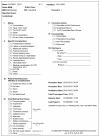Challenges and barriers to improving care of the musculoskeletal patient of the future - a debate article and global perspective
- PMID: 21943304
- PMCID: PMC3196685
- DOI: 10.1186/1754-9493-5-23
Challenges and barriers to improving care of the musculoskeletal patient of the future - a debate article and global perspective
Abstract
Background: With greater technological developments in the care of musculoskeletal patients, we are entering an era of rapid change in our understanding of the pathophysiology of traumatic injury; assessment and treatment of polytrauma and related disorders; and treatment outcomes. In developed countries, it is very likely that we will have algorithms for the approach to many musculoskeletal disorders as we strive for the best approach with which to evaluate treatment success. This debate article is founded on predictions of future health care needs that are solely based on the subjective inputs and opinions of the world's leading orthopedic surgeons.Hence, it functions more as a forum-based rather than a scientific-based presentation. This exposé was designed to stimulate debate about the emerging patients' needs in the future predicted by leading orthopedic surgeons that provide some hint as to the right direction for orthopedic care and outlines the important topics in this area.
Discussion: The authors aim to provide a general overview of orthopedic care in a typical developed country setting. However, the regional diversity of the United States and every other industrialized nation should be considered as a cofactor that may vary to some extent from our vision of improved orthopedic and trauma care of the musculoskeletal patient on an interregional level.In this forum, we will define the current and future barriers in developed countries related to musculoskeletal trauma, total joint arthroplasty, patient safety and injuries related to military conflicts, all problems that will only increase as populations age, become more mobile, and deal with political crisis.
Summary: It is very likely that the future will bring a more biological approach to fracture care with less invasive surgical procedures, flexible implants, and more rapid rehabilitation methods. This international consortium challenges the trauma and implants community to develop outcome registries that are managed through health care offices and to prepare effectively for the many future challenges that lie in store for those who treat musculoskeletal conditions.
Figures
Similar articles
-
The future of Cochrane Neonatal.Early Hum Dev. 2020 Nov;150:105191. doi: 10.1016/j.earlhumdev.2020.105191. Epub 2020 Sep 12. Early Hum Dev. 2020. PMID: 33036834
-
Critical Care Network in the State of Qatar.Qatar Med J. 2019 Nov 7;2019(2):2. doi: 10.5339/qmj.2019.qccc.2. eCollection 2019. Qatar Med J. 2019. PMID: 31763205 Free PMC article.
-
Who needs an orthopedic trauma surgeon? An analysis of US national injury patterns.J Trauma Acute Care Surg. 2013 Oct;75(4):687-92. doi: 10.1097/TA.0b013e31829a0ac7. J Trauma Acute Care Surg. 2013. PMID: 24064884
-
Ethical implications of regenerative medicine in orthopedics: an empirical study with surgeons and scientists in the field.Spine J. 2014 Jun 1;14(6):1029-35. doi: 10.1016/j.spinee.2013.10.016. Epub 2013 Nov 1. Spine J. 2014. PMID: 24184644 Review.
-
What Do Orthopedic Trauma Surgeons Want and Expect from Anesthesiologists?Anesthesiol Clin. 2022 Sep;40(3):547-556. doi: 10.1016/j.anclin.2022.06.004. Anesthesiol Clin. 2022. PMID: 36049881 Review.
Cited by
-
Improvement of research quality in the fields of orthopaedics and trauma: a global perspective.Int Orthop. 2013 Jul;37(7):1205-12. doi: 10.1007/s00264-013-1897-2. Epub 2013 May 21. Int Orthop. 2013. PMID: 23689761 Free PMC article. Review.
-
Collaborative multicenter trials in Latin America: challenges and opportunities in orthopedic and trauma surgery.Sao Paulo Med J. 2013;131(3):187-92. doi: 10.1590/1516-3180.2013.1313555. Sao Paulo Med J. 2013. PMID: 23903268 Free PMC article. Review.
-
Increased elastic modulus of plasma polymer coatings reinforced with detonation nanodiamond particles improves osteogenic differentiation of mesenchymal stem cells.Turk J Biol. 2018 Apr 27;42(2):195-203. doi: 10.3906/biy-1711-26. eCollection 2018. Turk J Biol. 2018. PMID: 30814881 Free PMC article.
-
Physician involvement in the care of multiply injured patients: the role of guidelines and subspecialties.Eur J Trauma Emerg Surg. 2012 Jun;38(3):209-10. doi: 10.1007/s00068-012-0193-y. Epub 2012 May 17. Eur J Trauma Emerg Surg. 2012. PMID: 26815951 No abstract available.
References
-
- US Census Bureau. US interim projections by age, sex, race, and Hispanic origin: 2000-2050. http://census.gov/population/www/projections/usinterimproj/ Accessed 2009 June 24.
-
- Loh S, George MV. Projected population size and age structure for Canada and provinces: with and without international migration. Can Stud Popul. 2007;34(2):103–127.
-
- Bhandari M, Schemitsch EH. Stimulation of fracture healing: Osteobiologics, Bone Stimulators, and Beyond. J Orthop Trauma. 2010;24(Suppl 3):S1. - PubMed
-
- Starr AJ, Smith WR, Frawley WH, Borer DS, Morgan SJ, Reinert CM, Mendoza-Welch M. Symptoms of posttraumatic stress disorder after orthopaedic trauma. J Bone Joint Surg Am. 2004;86-A(6):1115–1121. - PubMed
LinkOut - more resources
Full Text Sources


